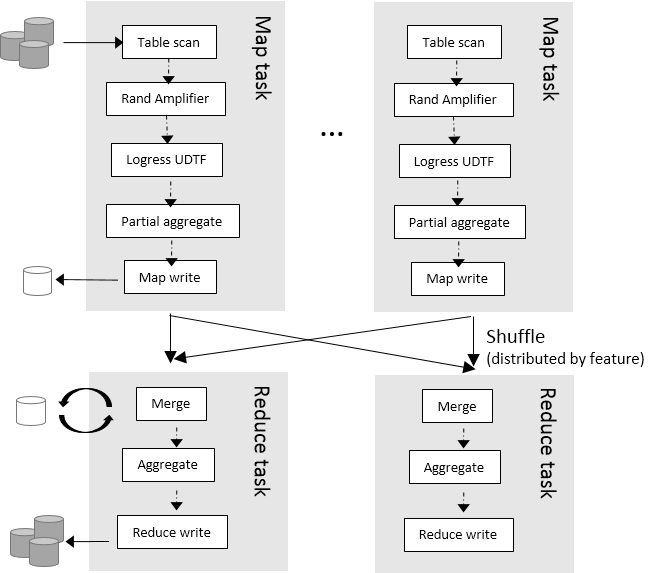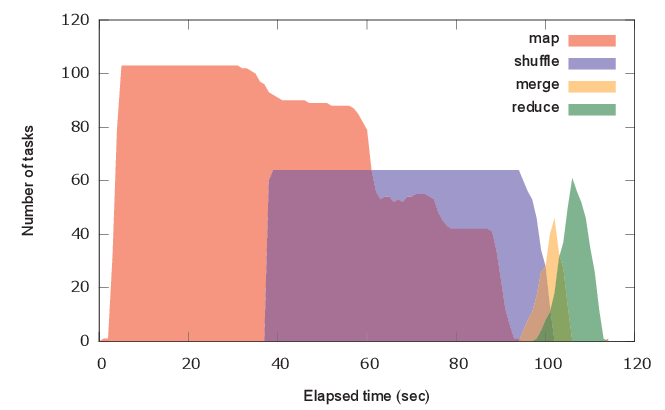This article explains amplify technique that is useful for improving prediction score.
Iterations are mandatory in machine learning (e.g., in stochastic gradient descent) to get good prediction models. However, MapReduce is known to be not suited for iterative algorithms because IN/OUT of each MapReduce job is through HDFS.
In this example, we show how Hivemall deals with this problem. We use KDD Cup 2012, Track 2 Task as an example.
WARNING: rand_amplify() is supported in v0.2-beta1 and later.
Amplify training examples in Map phase and shuffle them in Reduce phase
Hivemall provides the amplify UDTF to enumerate iteration effects in machine learning without several MapReduce steps.
The amplify function returns multiple rows for each row.
The first argument ${xtimes} is the multiplication factor.
In the following examples, the multiplication factor is set to 3.
set hivevar:xtimes=3;
create or replace view training_x3
as
select
*
from (
select
amplify(${xtimes}, *) as (rowid, label, features)
from
training_orcfile
) t
CLUSTER BY rand();
In the above example, the CLUSTER BY clause distributes Map outputs to reducers using a random key for the distribution key. And then, the input records of the reducer is randomly shuffled.
The multiplication of records and the random shuffling has a similar effect to iterations. So, we recommend users to use an amplified view for training as follows:
create table lr_model_x3
as
select
feature,
cast(avg(weight) as float) as weight
from
(select
logress(features,label) as (feature,weight)
from
training_x3
) t
group by feature;
The above query is executed by 2 MapReduce jobs as shown below:

Using trainning_x3 instead of the plain training table results in higher and better AUC (0.746214) in this example.
A problem in amplify() is that the shuffle (copy) and merge phase of the stage 1 could become a bottleneck. When the training table is so large that involves 100 Map tasks, the merge operator needs to merge at least 100 files by (external) merge sort!
Note that the actual bottleneck is not M/R iterations but shuffling training instance. Iteration without shuffling (as in the Spark example) causes very slow convergence and results in requiring more iterations. Shuffling cannot be avoided even in iterative MapReduce variants.

Amplify and shuffle training examples in each Map task
To deal with large training data, Hivemall provides rand_amplify UDTF that randomly shuffles input rows in a Map task. The rand_amplify UDTF outputs rows in a random order when the local buffer specified by ${shufflebuffersize} is filled.
With rand_amplify(), the view definition of training_x3 becomes as follows:
set hivevar:shufflebuffersize=1000;
create or replace view training_x3
as
select
rand_amplify(${xtimes}, ${shufflebuffersize}, *) as (rowid, label, features)
from
training_orcfile;
The training query is executed as follows:

The map-local multiplication and shuffling has no bottleneck in the merge phase and the query is efficiently executed within a single MapReduce job.

Using rand_amplify results in a better AUC (0.743392) in this example.
Conclusion
We recommend users to use amplify() for small training inputs and to use rand_amplify() for large training inputs to get a better accuracy in a reasonable training time.
| Method | ELAPSED TIME (sec) | AUC |
|---|---|---|
| Plain | 89.718 | 0.734805 |
| amplifier+clustered by | 479.855 | 0.746214 |
| rand_amplifier | 116.424 | 0.743392 |